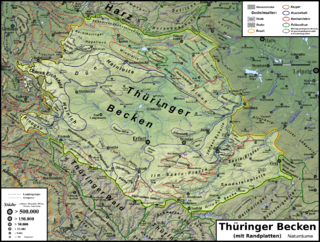Thuringian Basin

The Thuringian Basin[1][2] (German: Thüringer Becken) is a depression in the central and northwest part of Thuringia in Germany which is crossed by several rivers, the longest of which is the Unstrut. It stretches about 60 kilometres (37 mi) from north to south and around 120 kilometres (75 mi) from east to west. Its height varies from about 150 to 250 m above sea level (NN).
The Basin is surrounded by a wide outer girdle of limestone (
The elevation of the Thuringian Basin descends from the south and west to the east. While some of the marginal ridges have the character of low mountain ranges, there are no really noteworthy uplands within it, apart from the Ettersberg and Fahnerscher Höhe.
The Thuringian Basin is dominated by agriculture. Along with the
Other towns in the Thuringian Basin are (year of foundation and year of achieving town status in brackets):
- Schlotheim (974/1277)
- Ebeleben (1198/1928)
- Großenehrich
- Greußen/Clingen (?/1353 and 860/1282) to the north,
- Kindelbrück (775/1291)
- Weißensee(?/1265)
- Sömmerda (876/1350)
- Kölleda (786/1392)
- Rastenberg (1294/1412)
- Buttstädt (?/1331)
- Buttelstedt (780/1454)
- Neumark(1179/1326) to the east,
- Gebesee (786/1638)
- Bad Tennstedt (772/1340)
- Bad Langensalza (932/1212) in the centre
- Gotha(775/?) in the south
Large parts of the Basin in the former Thuringian
References
- ^ Elkins, T.H. (1972). Germany (3rd ed.). London: Chatto & Windus, 1972. ASIN B0011Z9KJA.
- ISBN 978-3-7301-0522-1.
- ^ Dickinson, Robert E. (1964). Germany: A regional and economic geography (2nd ed.). London: Methuen.
External links
